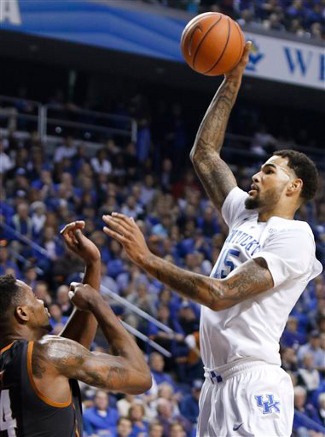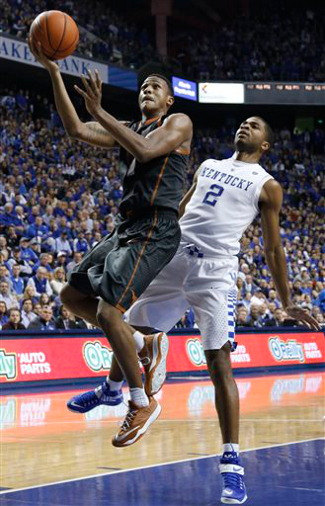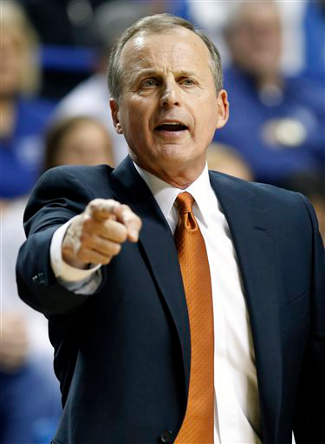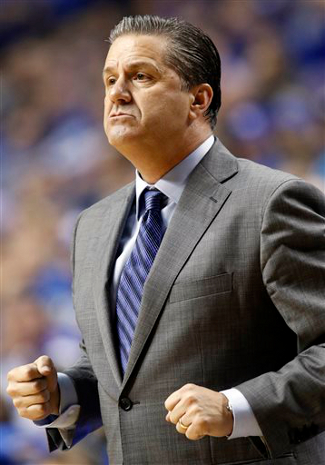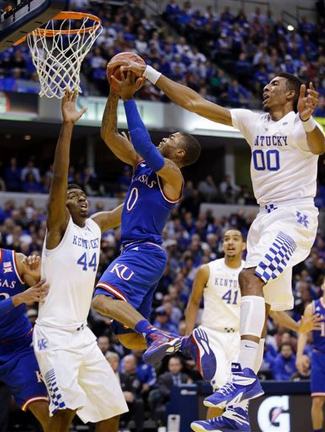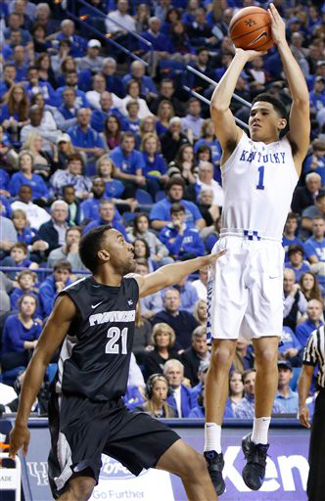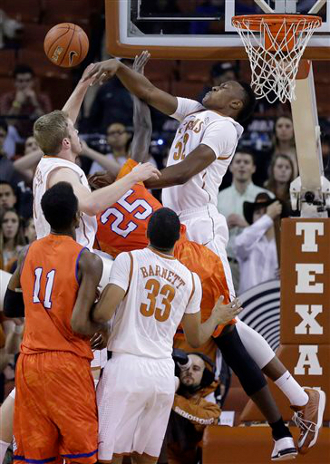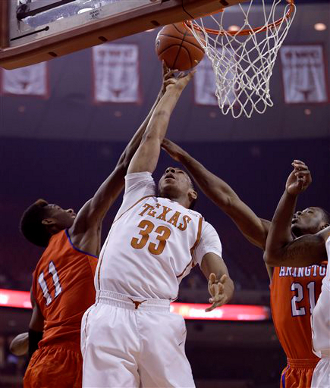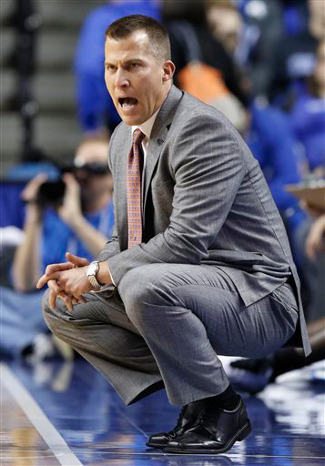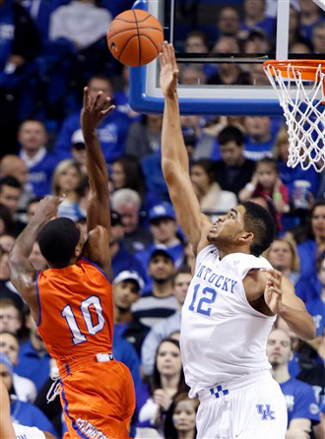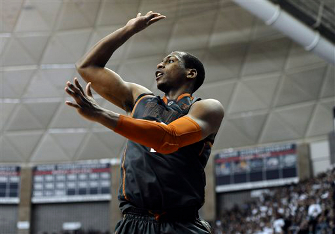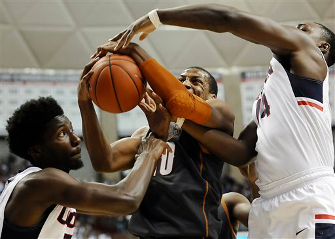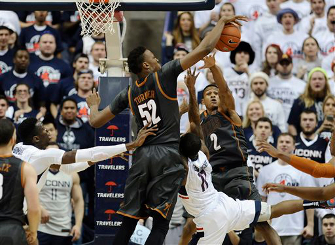As the Kentucky Wildcats charged out of the locker room in the second half, college basketball fans likely felt like they had seen this script before. The visiting Longhorns had played a tough 20 minutes to reach the half tied with Kentucky, taking away enough of UK’s strengths to overcome their own offensive struggles. But, as it had been with Providence and Buffalo earlier this year, the Longhorns soon saw just why No. 1 Kentucky is the most dangerous team in the country. The Wildcats surged ahead with a 10-0 run to open the half, and even built a lead as large as 16 points with less than 12 minutes to go.
Willie Cauley-Stein carried UK to victory But unlike the Friars and Bulls, the Longhorns refused to be buried. With 23,000 members of Big Blue Nation screaming at deafening levels, Texas clawed its way back into the game. Led by a poised Demarcus Holland, the Longhorns went on a 7-0 run of their own, and whittled the lead down to just five points with 1:44 to play. The Longhorns could not get any closer, as they failed to score on their final four possessions, and Kentucky padded the final margin with free throws and an authoritative alley-oop from Willie Cauley-Stein to cap the victory. Although the constant whistles were frustrating, and the Longhorns had many moments that were extremely maddening for fans, this had to be one of the most positive losing experiences for the program in recent memory. Texas stood toe-to-toe with the nation’s best team in a hostile road environment and battled through adversity that would have certainly caused recent Longhorn teams to crumble. Without starting point guard Isaiah Taylor, and with foul trouble forcing coach Rick Barnes to constantly shuffle his big men, the Longhorns acquitted themselves well on the biggest of stages. With the team now off all week due to finals, let’s take a look at six notes from a great showdown that Rick Barnes described as “a big-boy game.” 1. Horns dominated the glass, but lost the key rebounds Kentucky entered the game having won more than 48% of their offensive rebounding chances. That ability to extend possessions and get easy follows in the lane had helped to buoy their strong offensive efficiency numbers. Texas did a fantastic job eliminating that aspect of the UK offense in the first half, using a 2-3 zone to force Kentucky into jump shots, while grabbing almost every single rebound. The Longhorns won back 87.5% of UK’s missed shots in the first half, and prevented Kentucky from scoring any second-chance points. The final numbers say that Texas dominated the boards, as the Longhorns were the first team to win the rebounding battle against Kentucky this season, posting a 42-31 edge on the glass. However, Texas was so dominant on the boards in the first half that those overall stats obscure the fact that Kentucky won the boards when it mattered the most. The Wildcats reclaimed 67% of their missed shots in the second half and turned those into 10 second-chance points. On numerous occasions in the second half, Texas played excellent defense and forced a missed shot, only to see the Wildcats win it right back and make an easy follow. 2. Cameron Ridley continued to struggle The last two weeks have been extremely tough for the big man, and the first few minutes against Kentucky again put Ridley in a bad spot. In Texas’s first six possessions, Ridley missed a jumper and was tagged with two offensive fouls, forcing him to the bench for the remainder of the first half, having seen just three minutes of action. The big man was able to play an additional ten minutes in the second half, but again found himself whistled for an offensive foul midway through the second frame. Ridley has looked very tentative in recent weeks, seeming to freeze against pressure and double-teams. With the added complication of offensive fouls limiting his effectiveness even further, his only real impact on the game was five turnovers, including those three offensive fouls and a travel 25 feet from the basket. Texas proved that they could hang with one of the nation’s best frontcourts, even with Ridley sitting on the bench. However, if the Longhorns want to be able to compete at the highest level, they will have to find a way to raise Ridley’s confidence once again and generate consistent production from him in conference play. If not, they will find it tough sledding against teams with comparable size. 3. Prince Ibeh was an unlikely hero down low With Ridley neutralized early, Prince Ibeh was called on to provide minutes from the bench. On defense, his presence in the lane caused problems for the Kentucky frontcourt, as he made their shots in and around the lane very difficult. Ibeh battled foul trouble of his own, and you could clearly see the difference in the UK offense when he was riding the pine. On the other end of the court, Ibeh was the recipient of some nice drive and dish plays that he was able to flush home. As usual, every one of his trips to the free-throw line was an adventure, where no one — including Ibeh himself — could guess where each of his shots would go. On the night, he was just 2-for-8 from the line, bringing his season average down to 29.4%. With Ibeh’s defense being an integral part of Texas’s success, his ineptitude at the line will continue to be a glaring weakness for the Horns, and one that teams will surely exploit in close games.
Demarcus Holland impressed against the Wildcats 4. Demarcus Holland’s confidence is soaring With Taylor out of action, Holland has shown much more of the offensive aggression of which we’ve seen flashes in the last two seasons. His ability to pick the right opportunities for a quick drive have been on display in the last five games, and that led to five assists and a key three-point play last night. Holland also took over quite a bit of the ball-handling duties against the Wildcats, as Javan Felix struggled at the point. Kentucky likes to throw in some backcourt pressure to hurry opponents and force turnovers, but Holland proved himself a poised floor general in breaking that pressure. He repeatedly brought it up the floor and initiated the Texas offense, while only turning it over once on the night. While Holland’s emergence as a steady ballhandler and floor general is a big development in Taylor’s absence, it also gives the Longhorns additional options once Isaiah returns. If opponents know that Holland is able to drain it from deep — where he’s now 5-for-11 on the year — and can also easily find space with the bounce, it will very difficult for opponents to focus solely on the big men when he and Taylor are on the court. 5. Felix resisted the temptation to take bad shots With Holland taking over more of the ballhandling, Felix was able to slide back into his more natural role off the ball. As a result, it seemed like he took far fewer questionable shots, although his rushed three in the final few possessions came at an extremely inopportune time. Instead, Felix often opted to put the ball on the floor and find space inside the arc, where the length and speed of Kentucky forced him into some acrobatic misses. Even though Felix wasted less possessions by firing up bad, early shots, he did still cost Texas numerous possessions in other ways. Poor ball control and questionable passes resulted in five turnovers for the guard, something that was absolutely crippling in a close game against a highly-efficient team. It will be interesting to watch the backcourt dynamic in these final weeks of the non-conference schedule. If Holland emerges as the primary ballhandler, there’s reason for Texas fans to be optimistic that Felix will not only improve his shot selection, but also cut down on turnovers. It’s clear that Felix was put in a poor position by the Taylor injury, but Holland may be able to give him an opportunity for redemption by putting him back in his natural role. 6. The Longhorns again struggled with turnovers
Rick Barnes was frustrated by constant turnovers Felix and Ridley’s ten combined turnovers were just a fraction of the miscues that plagued Texas all night long. The Longhorns finished with 22 turnovers, wasting more than 32% of their possessions. With those turnovers including numerous offensive fouls and a shot clock variation, there were less opportunities for Kentucky to turn those miscues into easy fast-break points that could whip Big Blue Nation into a frenzy. Still, Texas should be commended for their ability to get back quickly on the live-ball turnovers and limit the number of points they gave up as a result. Even with the defense recovering and eliminating many of the fast-break opportunities, the Wildcats still scored 19 points off of the Texas mistakes. With the game separated by only two possessions in the final minutes, the Longhorns will certainly agonize over the ridiculous number of wasted opportunities and extra possessions that they gave Kentucky. Perhaps most troubling is that these problems are nothing new for the Longhorns. Although the 32.8% turnover rate was easily the highest for the Horns so far this season, it was the fourth consecutive game in which Texas coughed it up on more than 20% of their possessions. With a very tough Big 12 conference slate just a few weeks away, the Longhorns have little time to correct an extremely troubling trend. Up Next: vs. Texas State (4-1); Saturday, 7 P.M. CT (LHN) |








